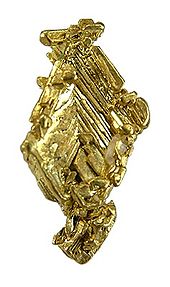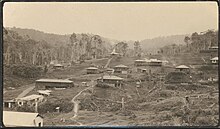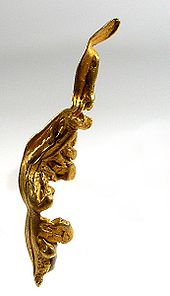Mining in Papua New Guinea


Mining in Papua New Guinea is an important part of the Papua New Guinea economy.
History
Up until 1970, there was little mineral extraction in Papua New Guinea. Since the 1970s, mineral extraction has dominated the national economy.[1]
With the exception of the Ok Tedy Mine (copper-gold) and the Ramu nickel-cobalt mine, almost all of the mining in PNG has been gold mining. The two largest gold mines are the Porgera (Enga Province) and Lihir (New Ireland Province) mines. In 2009, the Hidden Valley gold and silver mine (Morobe Province) commenced production.
All the mining activity that has taken place in the country since 1970 has produced approximately 5 million tonnes of copper between 1970 and 2007. The country produced 202,277 t of copper in 2003 compared to 211,315 in 2002, all of which was produced by the Ok Tedi Mine the most active mine in the country. The mine reported that 29.32 Mt of ore was mined (approximately 240,000 t/d material moved) and 29.26 Mt milled (77,000 t/d) with a head grade of 0.78% Cu and 0.8 g/t Au. Respective gold and copper recoveries for 2003 at Ok Tedy were 68% and 84%.
Mines
Edie Creek

Edie Creek has been a historic gold and silver mining area since its discovery in 1926.[2] Located about 5 km south-west of Wau, it was the centre of one of the first major gold rushes in PNG before World War II.[2] Large amounts of gold have been extracted by both alluvial and underground mining.[2] Brothers William and Stanley Royal found gold at Edie Creek in 1926. On 16 July 1951, a Qantas Drover aircraft crashed into the sea near Lae carrying gold belonging to the Bulolo Gold Dedging Company. It is believed that 35,000 pounds worth of gold bullion was on board. It was recovered later by special divers.[3] The remains can be seen here.
Frieda River
The Frieda River Project is situated on the border of Sandaun and East Sepik Provinces on a tributary of the Sepik River.
Hidden Valley/Hamata
Hidden Valley is an open-pit, gold-silver mine and processing plant in Morobe Province.[4] The mine is approximately 210 km north-north-west of Port Moresby, and 90 km south-southwest of Lae.[4] It is operated by Morobe Mining Joint Ventures, a 50:50 joint venture between Harmony, a company that operates primarily in South Africa, and Newcrest, an Australian gold and copper mining company.[4] The metals are epithermal deposits from hydrothermal systems related to volcanic activity.[5]
Kainantu
Construction of the Kainantu Gold Mine began in March 2004 and commenced operations in March 2006. In 2004 Landowners threatened to close down Highlands Pacific's Kainantu gold mine.[6] Kainantu Gold Mine is an underground mine and the concentrate is trucked to Lae and shipped to Japan for processing. In January 2009 production was halted. The mine has been designed to produce in excess of 100,000 ounces of gold per year. In 2007, a decision was made by Highlands Pacific Ltd. to sell Kuinantu Gold mine and licences to Placer Dome Oceania, a subsidiary of Barrick Gold Corporation for a cash price of US$141.5 million.[7][8][9] The mine is now owned and operated by K92 mining, a Canadian company.[citation needed]
Lihir
Lihir is an open cut gold mine operating on Lihir Island in the Bismarck Archipelago. It is wholly owned by Newcrest.
The company, incorporated in Papua New Guinea in June 1995, and named Lihir as its first project was to raise capital to build the Lihir Island gold mine was merged with Newcrest Mining at the end of August 2010 (the last day for trading of Lihir Gold shares was August 30, 2010).[10] Australian economist Ross Garnaut served as Lihir's chairman from 1995 to 2010.[11][12]
Merger talks were first made known in April 2010, with an announcement by Newcrest Mining. On Monday August 23, 2010 the A$9.5 billion takeover offer by Newcrest was approved after 99.86% of Lihir Gold Shareholders voted in favour of it.[13] The takeover received national court of Papua New Guinea approval on August 28, 2010.[14]
The acquisition made Newcrest Mining the world's fifth-largest gold producer with a production of 2.8 million ounces of gold (2009 combined production of the 2 companies).[15]
Misima
Misima Island is known as a mining island. A huge mine operated many years on the island. The Misima mine was a joint venture by Placer Dome (owning 80%) and the state-owned Orogen Minerals. In March 2012, Barrick closed its post closure monitoring office in Bwagaoia having successfully rehabilitated the mine and mill sites.
Since 2004 when the mine closed, artisanal mining has become a major source of income in the island, with an association Misima Alluvial Gold Mining Association (MAGMA) starting in 2007. Other sources of income, especially for people living on the north coast, are cash crops of coconuts, copra, and cacao. A commercial fisheries project has been proposed, but has not been developed yet.
Mt. Kare

Ok Tedi Mine
The Ok Tedi Mine is situated at Mount Fubilan in the Star Mountains in western PNG, close to the Indonesian border. OK Tedi Mining Limited is 100% Government owned (2014).
Panguna mine
Bougainville Copper (BC) developed the Panguna mine on Bougainville Island, producing copper concentrate from 1972 until May 1989, when mining operations were suspended due to civil unrest in the province.[16] Rio Tinto is a major shareholder of the BC (54%) and is currently reviewing its stake in the company. The deposit has a life of mine of some 20 years and has a capacity to produce 180 000t of copper and 480 000 oz gold per year. This development marked one of the first major investments in PNG, and was at one stage one of the world's largest copper - gold mines.
As of 2014, talks of restarting mining operations in Panguna mine have continued, with BC seeking official endorsement from the Autonomous Bougainville Government and the National Government of Papua New Guinea.[17]
Porgera
The Porgera Gold Mine is a large gold mining operation located in Enga province. The mine is located at the head of the Porgera Valley and end of the river and operated by Barrick Gold d.b.a. Porgera Joint Venture (PJV).
Ramu
The Ramu lateritic nickel-cobalt mining project is located in the Madang Province of Papua New Guinea. The 2022 annual output was 34,302 tonnes of nickel and 2,987 tonnes of cobalt contained in a mixed hydroxide intermediate product.[18][19]
The project comprises the Kurumbukari mine site and beneficiation plant, and a 135 kilometres (84 mi) slurry pipeline from the mine to the Basamuk processing plant. The mine is located on the Kurumbukari plateau, on the southern side of the Ramu River Valley, 75 kilometres (47 mi) to the southwest of Madang. The processing plant site is located on the coast of Basamuk Bay, 55 kilometres (34 mi) to the southeast of Madang.[18]
Discovered in 1962 by the Australian Bureau of Mineral Resources, the Kurumbakari project was explored intermittently by several companies. By the 1990s, Highlands Pacific completed detailed exploration followed by a feasibility study. In 2005, China Metallurgical Group Corporation (“MCC”) acquired the majority interest in the Project and Ramu NiCo Management (MCC) Limited became Manager and Operator for the Ramu Nickel Joint Venture. The mine project was commissioned in 2012 and achieved design capacity in 2017.[18][19]
Simberi Oxide Gold Project
Allied Gold, an Australian-based company, operate an open pit gold (and silver) mine called the Simberi Oxide Gold Project in the volcanic highlands on the eastern side of Simberi Island[20] Gold production started in February 2008 and the mine has a projected life of 8 years.[20] Production for the 2008 calendar year was 75,267 ounces (2,133,787 grams).[20]
Solwara 1
3°47′20″S 152°05′38″E / 3.789°S 152.094°E[21]
The Solwara 1 Project is located at 1600 metres water depth in the Bismarck Sea, New Ireland Province.[22] It will be the world's first deep sea mining project, with first production expected in 2013.[22][23] The resource is high grade copper-gold resource and the world's first Seafloor Massive Sulphide (SMS) resource.[22] Important minerals are created by the rapid cooling of the gases emerging from volcanic openings on the sea floor.[24] In 2014 a 20-year mining license was granted to a Canadian company.[25]
Woodlark
A mine in Mline bay province.[26]
Environmental impact of mining
Increased mining in Papua New Guinea has caused notable environmental impacts. Papua New Guinea has permitted the direct discharge of tailings to its rivers and seas for decades.[27]
After the construction of an open-cut gold mine and an ore-processing facility on Misima Island in 1988, large increases of sedimentation caused a decrease in tissue-layer thickness of a nearby coral reef.[28] Mining in the Ok Tedi Mine also increased sedimentation in the Ok Tedi River by 5-10 times. The poisonous waste reaches the Fly River where it kills fish and trees, and poisons croplands and drinking water.[29] Increased sediment load in the river has caused high concentrations of dissolved copper in the inner floodplain.[30]
Reserves and mineral exports
Papua New Guinea has large reserves of minerals and gas. The mineral exports are gold, silver, copper, nickel, and cobalt. According to the Bank of Papua New Guinea's Quarterly Economic Bulletin, the weighted average kina price of Papua New Guinea's export commodities (excluding LNG) increased by 20.7% in September 2021, compared to an increase of 2.5% in the corresponding quarter of 2020. There was an increase of 16% in the weighted average price of mineral exports, compared to an increase of 8.2% in the corresponding quarter of 2020.[31]
References
- ^ "Papua New Guinea". Retrieved February 1, 2010.
- ^ a b c "Exploration & Mining Bulletin Quarterly Bulletin" (PDF). Mineral Resources Authority of Papua New Guinea. March 2008. Retrieved 11 January 2011.
- ^ Sea Yields Gold Lost In Lae Air Disaster The West Australian 22 November 1952 page 10
- ^ a b c "Hidden Valley". Harmony Gold Mining Company Limited. 2010. Archived from the original on 13 August 2010. Retrieved 10 September 2010.
- ^ "Harmony Annual Report 2010" (PDF). Harmony Gold Mining Company Limited. 2010. p. 155. Retrieved 12 November 2010.
- ^ Bromby, Robin (August 19, 2011). "Confidence the first victim of PNG's resources play". The Australian. Retrieved 9 March 2014.
- ^ BSP Investor. "Highlands Pacific (ASX:HIG)". Retrieved 9 March 2014.
- ^ ACTNOW. "Kainantu gold mine". Retrieved 9 March 2014.
- ^ PNGIndistruNews. "Barrick struggles against rising costs". Retrieved 9 March 2014.
- ^ Kiladze, Tim (2010-08-30). "Last day of trading for Lihir Gold". Globe & Mail. Toronto.
- ^ Chambers, Matt (24 August 2010). "Lihir Gold to accept Newcrest's takeover offer". The Australian.
- ^ Kiladze, Tim (30 August 2010). "Last day of trading for Lihir Gold". Globe & Mail. Toronto.
- ^ "Lihir Gold Shareholders Approve Merger With Newcrest Mining". Fox Business. 2010-08-23.[permanent dead link]
- ^ "Court clears Newcrest's $22.3-bn Lihir Gold takeover". Domain-b.com. Retrieved 2012-06-18.
- ^ Newcrest Proposed Combination with Lihir Archived 2011-07-06 at the Wayback Machine Newcrest 1 April 2010
- ^ "About the Company". Archived from the original on 23 September 2015. Retrieved 24 August 2015.
- ^ "Bougainville Copper Limited". Archived from the original on 23 September 2015. Retrieved 24 August 2015.
- ^ a b c Deng, Qingping; Ingham, Peter D.; Nice, Roland; Brett, Adrian (19 July 2019). ""Ramu Nickel Cobalt Operations, located in Madang Province – Papua New Guinea, NI 43-101 Technical Report" (PDF). Sydney: Behre Dolbear Australia. p. 12. Retrieved 15 February 2024.
- ^ a b "Management's Discussion & Analysis for the Three months ended April 30, 2023" (PDF). Toronto, Ontario: Nickel 28 Capital Corp. 27 June 2023. Retrieved 15 February 2024.
- ^ a b c "Simberi". Mineral Policy Institute. Archived from the original on 16 February 2011. Retrieved 9 September 2010.
- ^ Lipton, Ian (2008-02-01). "Mineral Resource Estimate, Solwara 1 Project, Bismarck Sea, Papua New Guinea for Nautilus Minerals Inc" (PDF). Golder Associates Pty Ltd. Archived from the original (PDF) on 5 July 2010. Retrieved 14 September 2010.
- ^ a b c "Solwara 1 Project – High Grade Copper and Gold". Nautilus Minerals Inc. 2010. Archived from the original on 12 August 2010. Retrieved 14 September 2010.
- ^ Hill, Matthew (2010-09-07). "Nautilus says could start undersea mining in 2013". Mining Weekly. Retrieved 14 September 2010.
- ^ Childs, John (19 February 2019). "Deep sea mining threatens indigenous culture in Papua New Guinea". The Conversation. Retrieved 2020-08-10.
- ^ Kaknevicius, Ariana (13 May 2014). "Canadian mining company could be involved in world's first deep sea mine". Canadian Geographic. Retrieved 24 March 2015.
- ^ "Woodlark Gold Project - Geopacific Resources Limited". 2 November 2021.
- ^ Mudd, Gavin M.; Roche, Charles; Northey, Stephen A.; Jowitt, Simon M.; Gamato, Gama (1 November 2020). "Mining in Papua New Guinea: A complex story of trends, impacts and governance". Science of the Total Environment. 741. Bibcode:2020ScTEn.74140375M. doi:10.1016/j.scitotenv.2020.140375. PMID 32599403. Retrieved 6 June 2023.
- ^ Barnes, D. J.; Lough, J. M. (1999). "Porites growth characteristics in a changed environment: Misima Island, Papua New Guinea". Coral Reefs. 18 (3): 213–218. doi:10.1007/s003380050185. S2CID 27834800.
- ^ Togiba, Lyanne; Doherty, Ben (7 June 2021). "Mining in the Pacific: a blessing and a curse". The Guardian. Retrieved 6 June 2023.
- ^ Hettler, J.; Irion, G.; Lehmann, B. (1997). "Environmental impact of mining waste disposal on a tropical lowland river system: A case study on the Ok Tedi Mine, Papua New Guinea". Mineralium Deposita. 32 (3): 280–291. Bibcode:1997MinDe..32..280H. doi:10.1007/s001260050093. S2CID 129650097.
- ^ "Papua New Guinea - Mining Equipment and Services". www.trade.gov. Retrieved 2023-08-27.
External links
- PNG Chamber of Mines and Petroleum
- Mineral Resources Authority (MRA) of Papua New Guinea
- Map of mining projects 2010
- Mining Journal special publication – Papua New Guinea (November 2009)
- The regulation of exploration and extraction in 31 jurisdictions worldwide - Papua New Guinea (2010). Law Business Research Ltd
- Photo Gallery: Mining in Papua New Guinea 1983-2010
- Mining in Papua New Guinea - InfoMine
- PNG Mining News & Information
- Press review: Mining in the South Pacific (since May 2009)

